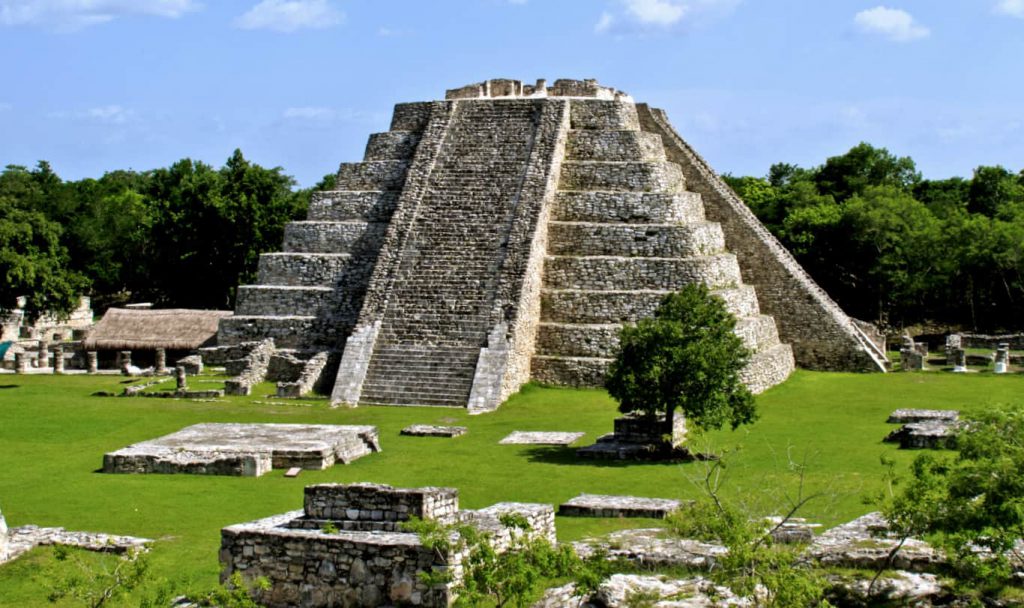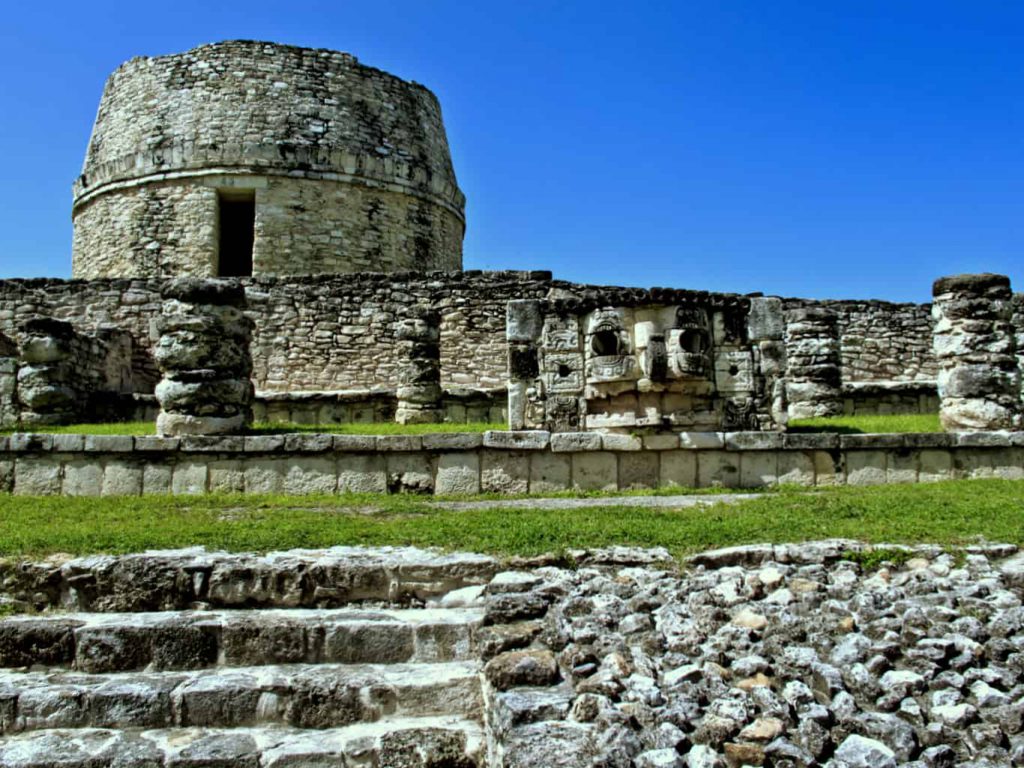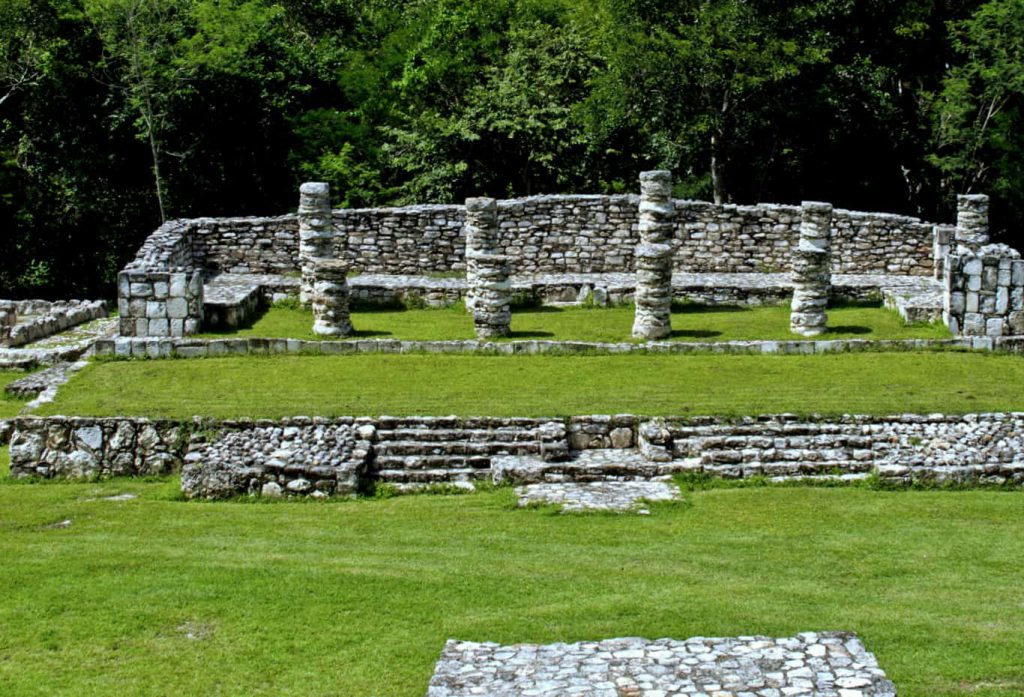Mayapan – last big town of the ancient Maya in Yucatán
Mayapan is a historic site of the Maya in the northwest of the Yucatán Peninsula. It is considered to be the last big Mayan town in the history of ancient Mayan civilization. Mayapan was actually the capital of the Maya in Yucatán for a period of about 200 years. The ruins are located about 40 km south of Merida in the dry northern lowlands of Yucatán.
The bloom of Mayapan was during the post-classical period and reached its peak between 1250 and 1442 AD. It is assumed that the founding of the city was accomplished around 1000 AD. The place, however, was already populated in the early classical period, as various archaeological discoveries can prove.

Mayapan – last capital of the Maya
Mayapan was surrounded by a 9 km long wall. Twelve gates allowed the access to the interior of the city. About 12,000 people lived at about 4 square kilometers, protected by the fortification. Overall, more than 4,000 buildings have been found in that area.
The area outside the city walls was also colonized. It is believed that outside the urban area 5,000 people lived in addition.
Walls that were built around settlements normally indicate turbulent times. In the case of Mayapan it is doubtful that this fortification was actually useful as a military bulwark, because there are doubts that it could have been defended by the city’s population simply due to its length.

The structure of the city reflects the structure of the society. The higher standing the residents were in the social hierarchy of the Maya, the closer to the city center of Mayapan they lived. The common people lived at the edge regions.
There are various attempts to explain the meaning of the name, the most sense seems to me the explanation that the word Mayapan is formed from the two parts of “May” (Yucatec Maya: “Circle”) and Apan (Nahuatl: “Water”).

In the Chilam Balam books one can find a list of city names including Mayapan, in combination with the words “Ich-Paa ‘, meaning “surrounded by a wall”. (Source: Precolumbian Water Management: Ideology, Ritual, and Power)

Mayapan – Rise and Fall
The history of the Maya can be reconstructed only partially from different sources contradicting each other. Valuable sources are inscriptions found on steles and buildings, indigenous chronicles like the Chilam Balam and records from the colonial era, as the Relaciones de Yucatán by Diego de Landa.
The validity of these rather scantily written records must eventually be supported by the archaeological researches.

From these sources, the following facts about Mayapan can be interpreted:
A Maya prince named Hunak Ke’el, a native of the nearby village Techaquillo and member of the family of Cocom, was captured at about 1194 in Chichén Itzá and was thrown into the “cenote” of this city for the purpose of sacrifice.
However Hunak Ke’el survived this most likely involuntary procedure. As a result of the operation he declared war on Chichén Itzá and finally destroyed the city around 1224. This led to an end of the dominance of the Itzá in northern México. The Itzá retreated to their original area at the Lago Petén in Guatemala, where they were defeated by the Spanish colonizers in 1697.

The dynasty of the Cocom began to dominate of the northern Yucatán. In the wake of the war Mayapan was founded by Hunak Ke’el. Which coincides with the bloom of the city and the construction time of major buildings.
An uprising of the princely family of Xiu from the region Mani ended this heyday of the Cocom family. With the uprising in the years 1441-1461, almost all members of the House Cocom were killed and Mayapan was destroyed. There is, though unsecured, evidence that at about the same time an unknown epidemic could have raged that could have contributed to the downfall of Mayapan.

In any case, the are findings of mass graves dating to this time, where the bodies show clear signs of external influence by weapons.
The ancient Mayan families haven’t been distinct completely and survived even the conquest of the Spanish invaders. Today there are still descendants of the Cocom, as well as the Xiu living in Yucatán.
After the destruction of the kingdom, Mayapan broke into several small competing principalities. This was also the condition that the Spanish conquistadors encountered in the 16th century.
The conquest of the Mayan area then took nearly 200 years, and repeatedly flare-up of the Maya happened up to the present time.

Buildings in Mayapan – pyramid, portico, round temple
At the center of administrative-religious area of Mayapan is the nine-step pyramid of Kukulkan. It is a scaled-down shape of the pyramid of the same name in Chichén Itzá with 15 m height.
The pyramid at Mayapan was not worked out by far as the building in Chichén Itzá.
While a panel of hewn stones was used for the pyramid of Chichén Itzá, in Mayapan it was only plastered and painted with colors.
Other worth seeing and relatively well-preserved buildings are the porticos, the ball court and various circular temple, similar to the Caracol, the snail tower at Chichén Itzá.
Unlike in Chichén Itzá, this circular temple is not created as an astronomical observatory, but dedicated to the Mayan “God of the Wind”.
How to get there
It is the best to combine the visit of Mayapan with a stay in Merida, the capital of the province of Yucatán. Thus you can not only enjoy the city life of Merida, but can visit other interesting Mayan sites such as Uxmal starting from Merida as a central point.
To reach the site of Mayapan 40 km south of Merida, you have to calculate about an hour’s drive.
One should make sure not to confuse the Mayan ruins with a village of the same name 40 km away. The site is few km south of a village called Telchaquillo (see map). Scroll into the map to see a plan of the archaeological site of Mayapan.
The correct name for ancient Mayan site is Z.A. Mayapan – Z.A. means Zona Archaeologica.
Public transportation can be used as well. The bus from Merida to Mayapan leaves from the bus station on Calle 67 between 50 and 52. Buses leave about every hour. Driving time by bus is around 1,5 hours.

Further reading:
>>> Yucatán Before and After the Conquest (Native American)by Diego de Landa
Es muy importante tratar de preservar estos sitios para nuestras generaciones futuras. Pero mas Importante recordar que esto existe, gracias al trabajo de nuestros abuelos de antes y también de ahora. Solo que se no se valora la acción de los viejos mayas de hoy que todavía poseemos algo de lo que se valora, dejado por los anteriores. Poco a poco va desapareciendo estos conocimientos, no solo de mayas sino de todos los grupos originarios que con el tiempo terminará por desaparecer. Positivo para nuestra existencia, negativo? El turismo místico tiene u concepto; el turismo normal solo viene a admirar lo antiguo sin pensar el origen de su admiración, que está olvidado y en muchos casos menospreciado.